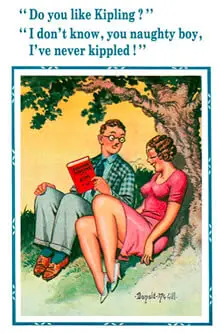A figure of speech in which a phrase can be understood in two ways – one of them risqué. Commonly used to convey sexual puns.
Double Entendre
What's the meaning of the phrase 'Double Entendre'?
What's the origin of the phrase 'Double Entendre'?
‘Double entendre’ is a very suitable name for an expression that is intended to convey ambiguity as its own origin is spurious. It purports to be a French phrase and, in the mind of the English in the 17th century when the phrase was coined, anything French was inescapably risqué. In fact, the French phrase for ‘double meaning’ was then ‘double entente’ and more recently ‘double sens’. ‘Double entendre’ was the invention of the English playwright John Dryden in the 1673 comic play Marriage a-la-Mode:
Foible, Chagrin, Grimace, Embarrasse, Double entendre, Equivoque.
It is indeed in England where double entendres are most fondly regarded, as much today as in the past. This could be because the residents prefer to hide sexual references behind a veil of respectability or it may be because double entendres are essentially ironic and no one enjoys comic irony like the English. If there can be said to be a collective English sense of humour, the gentle smutty wordplay of the seaside postcard, radio comedians and Ealing comedies is a strong contender.
There are myriad examples of double entendres in English and
The history of “Double Entendre” in printed materials
Trend of double entendre in printed material over time
Related phrases and meanings
Browse more Phrases
About the Author

Phrases & Meanings
A-Z
A B C D E F G H I J K L M N O P Q R S T UV W XYZ
Categories
American Animals Australian Bible Body Colour Conflict Death Devil Dogs Emotions Euphemism Family Fashion Food French Horses ‘Jack’ Luck Money Military Music Names Nature Nautical Numbers Politics Religion Shakespeare Stupidity Entertainment Weather Women Work
How did we do?
Have you spotted something that needs updated on this page? We review all feedback we receive to ensure that we provide the most accurate and up to date information on phrases.
